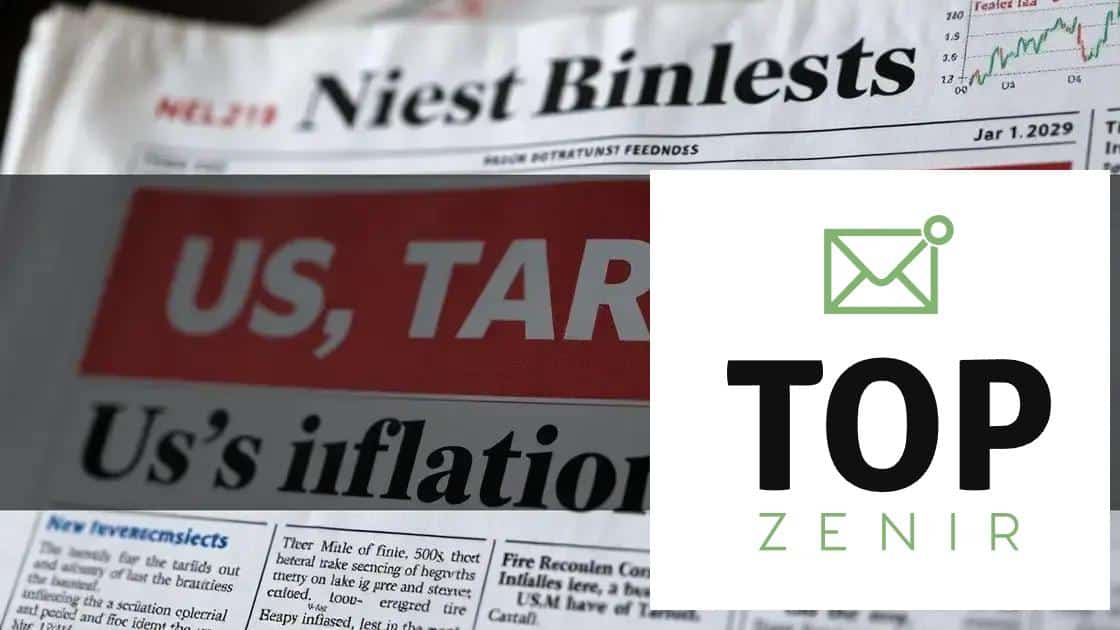Tariff changes influence US inflation expectations

Tariff changes influence US inflation expectations by increasing consumer prices as higher import costs are typically passed on to buyers, impacting economic spending and growth.
Tariff changes influence US inflation expectations in ways that can surprise many. Have you ever wondered how these alterations affect your wallet? In this article, we’ll break it down and explore the potential implications for everyday consumers.
Understanding tariff changes and inflation
Understanding how tariff changes affect inflation is crucial for consumers and businesses alike. When tariffs are adjusted, it often leads to significant economic shifts that can subtly influence prices across various sectors.
How Tariffs Impact Inflation
When tariffs are increased, the costs for imported goods can rise. Businesses, in turn, may pass these costs onto consumers, resulting in higher prices for everyday items. Let’s explore a few key areas affected by these changes.
- Consumer goods: Imported products, like electronics and clothing, may see price hikes.
- Raw materials: Industries relying on imported materials could face higher production costs.
- Local businesses: Increased costs can harm smaller businesses that cannot absorb these expenses.
These price changes can create a ripple effect in the economy. For instance, if consumers spend more on essential goods, they may have less to spend on other items, which can slow economic growth.
Monitoring the Economic Landscape
It’s important to keep an eye on economic indicators that reflect how effective these tariff changes are in controlling inflation. Analysts often look at metrics such as the Consumer Price Index (CPI) and Producer Price Index (PPI) to gauge these effects. Higher prices in these reports can signal inflationary pressures stemming from new tariffs.
As tariffs continue to evolve, their impacts can shift. Governments may impose or lift tariffs based on current market conditions, geopolitical factors, or aims of promoting domestic industries. This unpredictability can create uncertainty for consumers and businesses.
In light of these dynamics, understanding tariff changes is essential for making informed purchasing decisions and business strategies. By staying informed, both consumers and businesses can better navigate the complexities of an ever-changing economic landscape.
Historical impact of tariffs on inflation
The historical impact of tariffs on inflation reveals a complex relationship between government policy and economic conditions. Over the years, tariffs have played significant roles in shaping inflation rates across various time periods.
Key Historical Moments
Several key events illustrate how tariff changes can influence inflation. For example, the Smoot-Hawley Tariff Act of 1930 significantly increased duties on imports, leading to retaliation from other countries and escalating prices.
- 1930s: The Smoot-Hawley Tariff raised prices but worsened the Great Depression.
- Post-World War II: Tariffs were lowered to stimulate trade and economic recovery, helping reduce inflation.
- 1970s: Trade barriers reinstated to protect industries, contributing to stagflation.
The effects were not short-term. For instance, decades following the Great Depression highlighted how high tariffs could stifle economic growth. Conversely, during the post-war era, reduced tariffs fostered international trade, which often correlated with lower inflation.
Lessons from the Past
Understanding past tariff impacts provides insights for today’s economic environment. A balance must be struck between protecting domestic industries and ensuring low prices for consumers. High tariffs can cushion local businesses but may also lead to increased prices for consumers, sparking inflation.
Moreover, historical data emphasizes the importance of global trade dynamics. When countries engage in retaliatory tariff measures, it often creates a cycle of rising costs. Hence, careful consideration of past occurrences can guide future policy decisions to avoid detrimental inflationary effects.
Current trends in US tariffs
Current trends in US tariffs highlight ongoing changes in trade policy that impact the economy and consumers. As the global market evolves, the United States is adjusting its tariffs to meet new challenges and opportunities.
Recent Policy Changes
In recent years, policymakers have shifted their approach to tariffs. The introduction of new tariffs has sparked debates about their effects on various industries and the overall economy. Some sectors have benefited from protectionist measures, while others have faced increased costs.
- Import tariffs on steel and aluminum: These tariffs were enacted to support domestic production but have raised prices for consumers.
- Tariffs on Chinese goods: Significant tariffs were placed on various products, leading to trade negotiations and retaliatory tariffs.
- Removal of certain tariffs: In some cases, tariffs have been reduced to help reduce inflationary pressures.
The debate surrounding these policies is ongoing. Many argue that tariff changes can protect local jobs and industries, while critics say they can lead to higher prices for consumers. These dynamics require constant monitoring and adjustment to balance economic growth and inflation.
Impact on Inflation and Prices
Current trends show that tariffs play a crucial role in shaping inflation rates. When tariffs increase, the cost of imported goods tends to rise. This can have a direct impact on consumer prices, as businesses may pass these increased costs onto customers.
Moreover, the government is partly responsible for keenly assessing global market conditions. Tariff policies must consider international trade’s influence, as other countries may retaliate with their tariffs, further complicating the economic landscape.
A close watch on these current trends in US tariffs provides valuable insights into the economic future. While the intention behind tariff changes may aim to support domestic industries, the broader implications for inflation and consumer pricing remain important considerations.
The relationship between tariffs and consumer prices

The relationship between tariffs and consumer prices is an essential aspect of economic policy. When tariffs are imposed on imported goods, the costs often shift directly to consumers. This makes understanding the connection vital for anyone concerned with their budget and spending.
How Tariffs Affect Prices
When goods are taxed at the border, importers face higher costs. These costs can lead to increased prices for consumers. This influence is particularly noticeable in everyday items such as groceries, electronics, and clothing.
- Increased production costs: Domestic manufacturers using imported materials may raise prices to cover higher costs.
- Reduced competition: Tariffs can limit imports, reducing competition and allowing domestic sellers to elevate their prices.
- Price fluctuation: Market uncertainty can cause prices to rise further as consumers react to anticipated increases.
As tariffs increase, consumers begin to notice changes in what they pay at stores. For instance, if tariffs on steel rise, the price of cars and appliances can also climb due to higher production costs for manufacturers. When tariffs are reduced, it may lead to lower prices, benefiting consumers.
Consumer Responses to Price Changes
Consumers often adjust their spending habits when faced with rising prices due to tariffs. They might switch to cheaper alternatives or reduce overall spending. This behavior can have significant implications for the economy.
Moreover, the connection between tariffs and consumer prices illustrates the importance of trade policies. Policymakers must carefully consider how their decisions impact everyday life. By balancing protection for local industries and consumer affordability, they aim to foster a healthy economic climate.
Expert opinions on future inflation predictions
Expert opinions on future inflation predictions provide valuable insights into the economic landscape. As economists analyze ongoing trends, their forecasts help businesses and consumers prepare for potential changes in prices and spending.
The Role of Economists
Economists use various tools and indicators to predict inflation. They look at factors such as employment rates, consumer spending, and international trade. By understanding these elements, they can make educated forecasts about inflation trends.
- Consumer Price Index (CPI): This measure tracks price changes over time and is crucial in predicting inflation.
- Market Expectations: Economists also consider how businesses and consumers expect prices to change.
- Federal Reserve Policies: Changes in interest rates and monetary policy significantly affect inflation predictions.
Many experts have differing views on inflation’s trajectory. Some predict a rise in inflation due to supply chain issues and increased demand, while others believe easing measures and production increases may stabilize prices.
Factors Influencing Predictions
Inflation is often influenced by several key factors. These can include geopolitical events, natural disasters, and shifts in consumer behavior. For example, disruptions in supply chains can lead to shortages, driving prices up.
Moreover, global economic conditions can also play a significant role. When economies around the world grow or slow down, it can affect demand for U.S. products, impacting inflation rates.
Experts constantly reassess their predictions based on new data. A rapidly changing economic environment makes it essential for them to adapt their forecasts. By staying informed, both consumers and businesses can better prepare for the potential impacts on their finances.
FAQ – Frequently Asked Questions about Tariff Changes and Inflation
How do tariff changes affect consumer prices?
Tariff changes can lead to higher prices for imported goods, which may increase consumer prices as businesses pass on the costs.
What do economists use to predict inflation?
Economists use indicators like the Consumer Price Index (CPI), employment rates, and trade data to forecast inflation trends.
How can consumers respond to rising prices due to tariffs?
Consumers may switch to cheaper alternatives or modify their spending habits to cope with increased prices resulting from tariffs.
What is the impact of global conditions on US tariffs?
Global economic conditions, such as supply chains and international trade relations, significantly influence the effectiveness and implementation of US tariffs.





